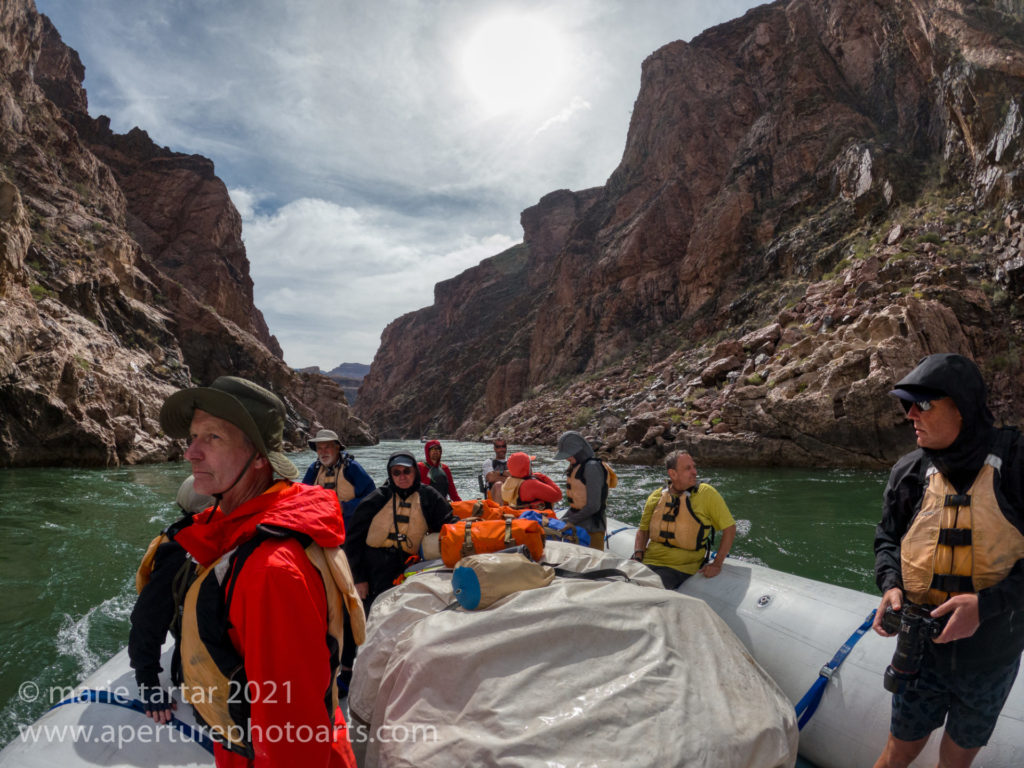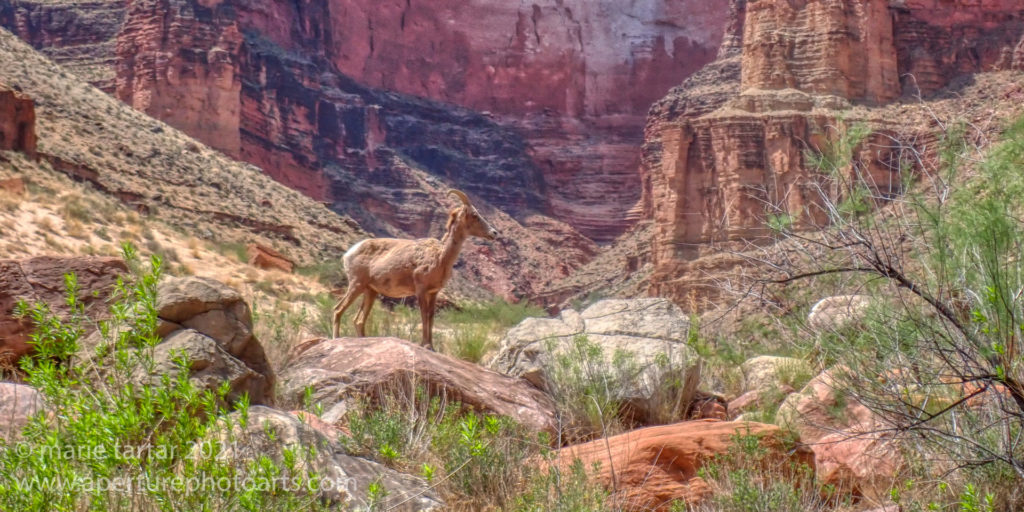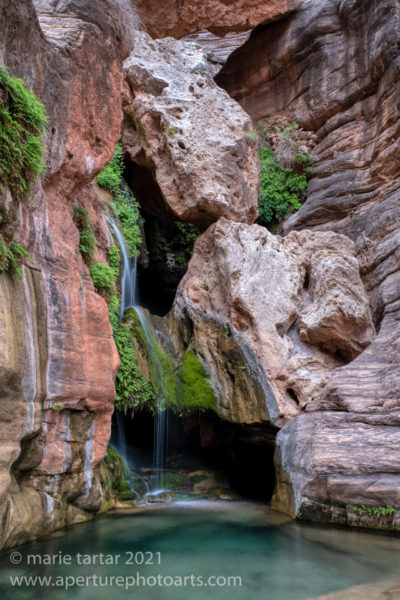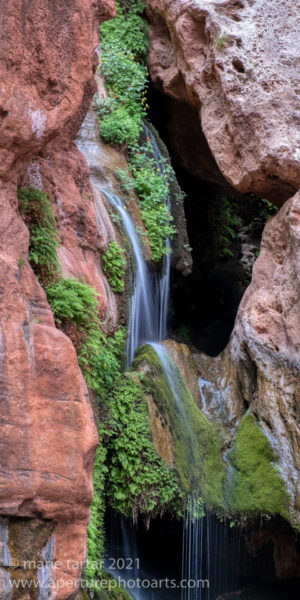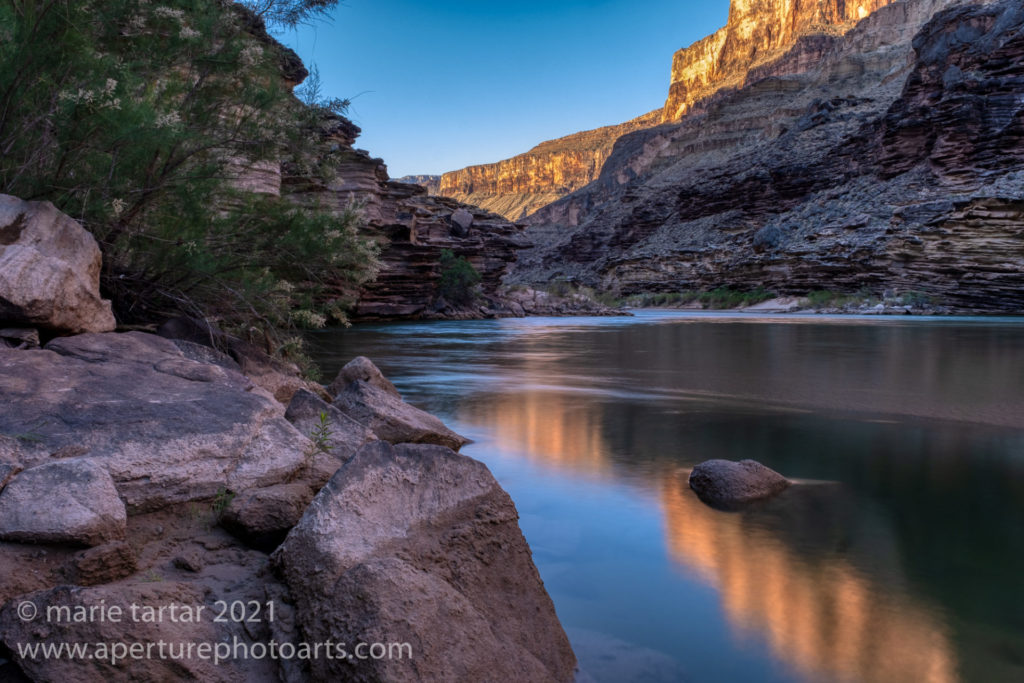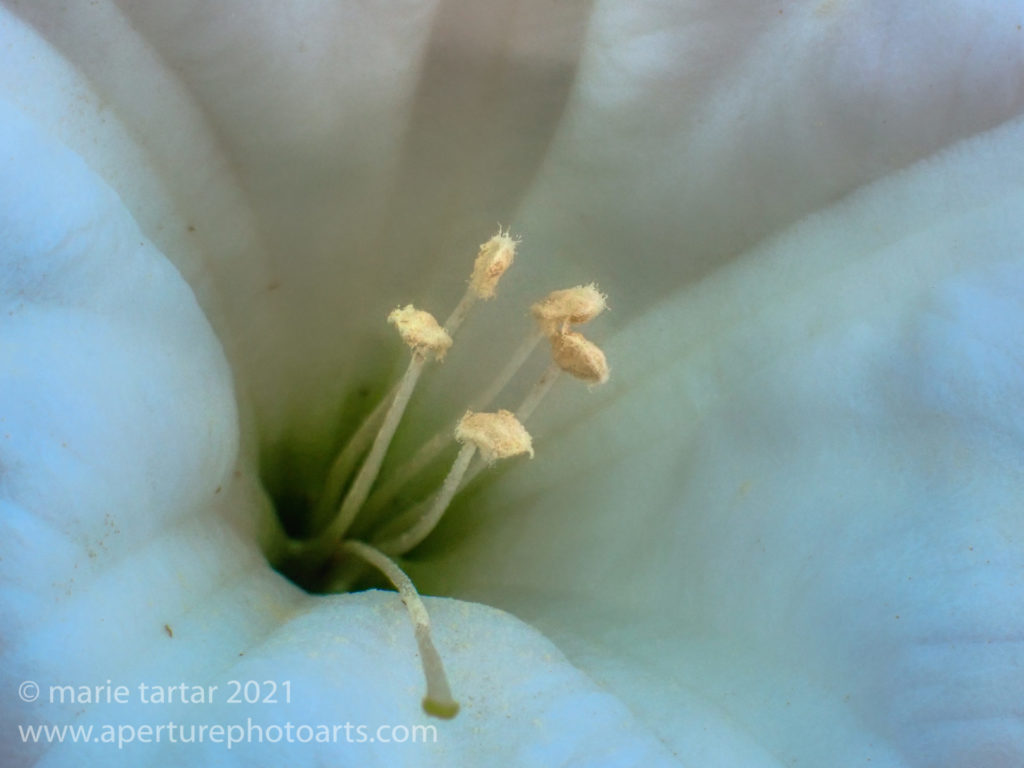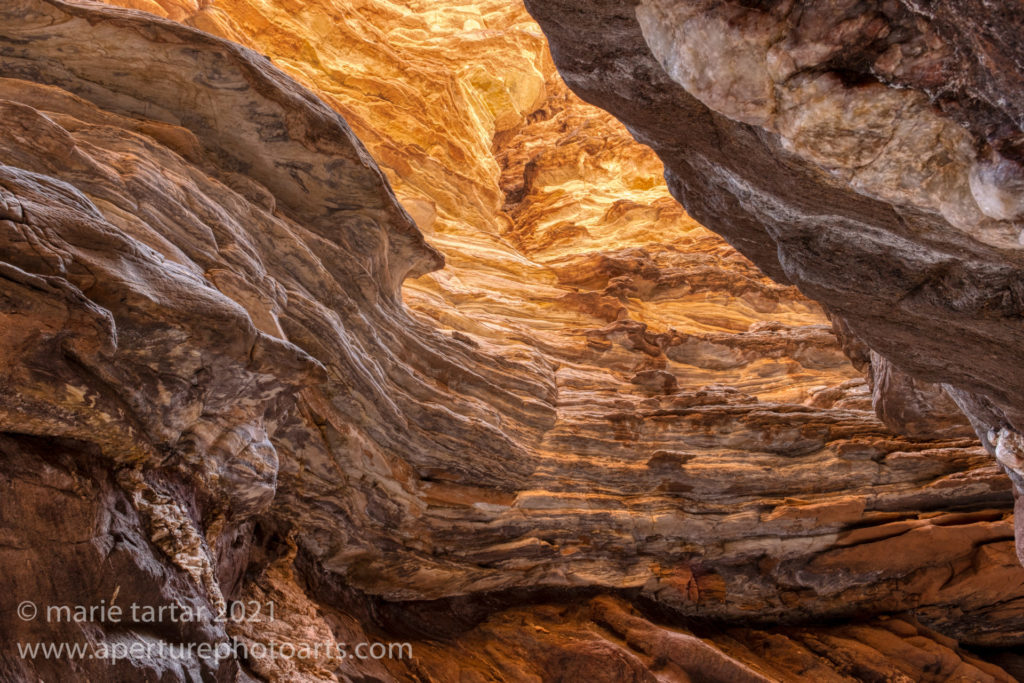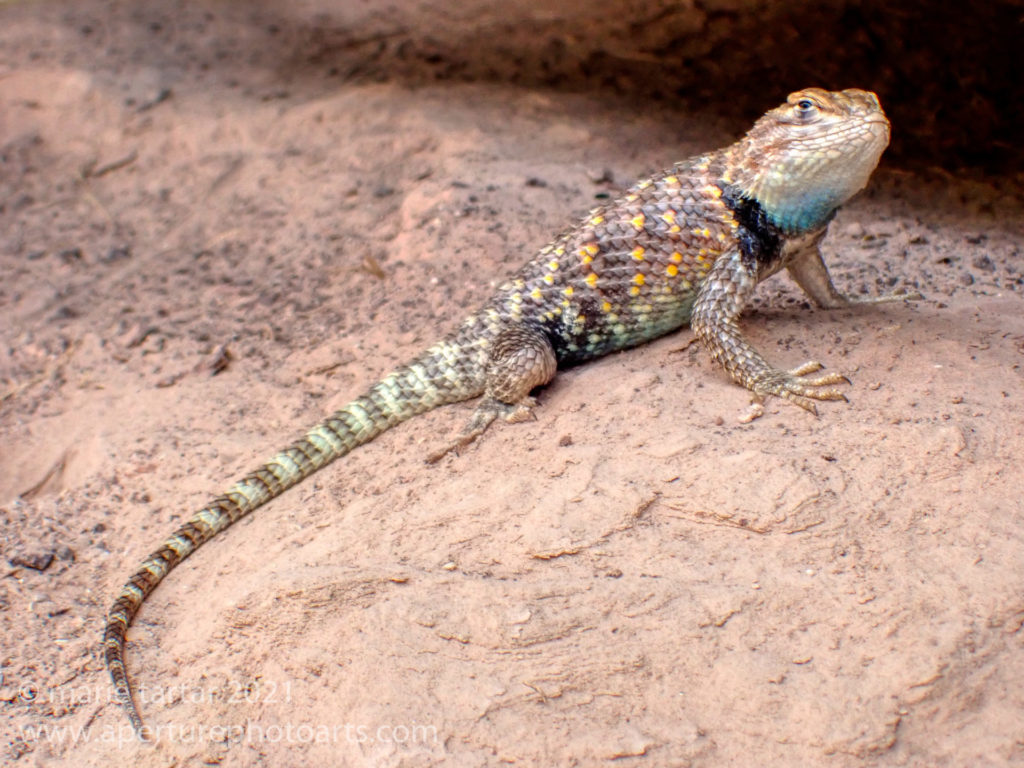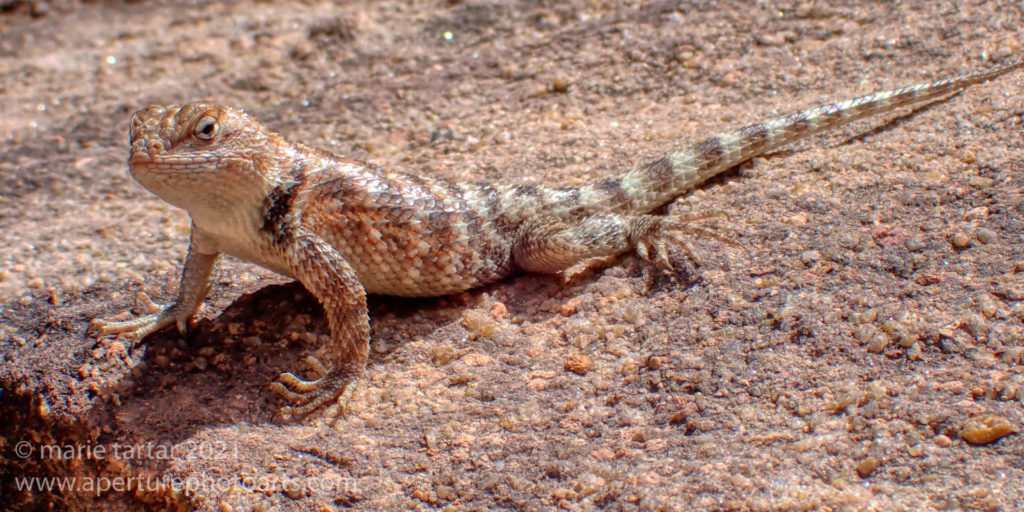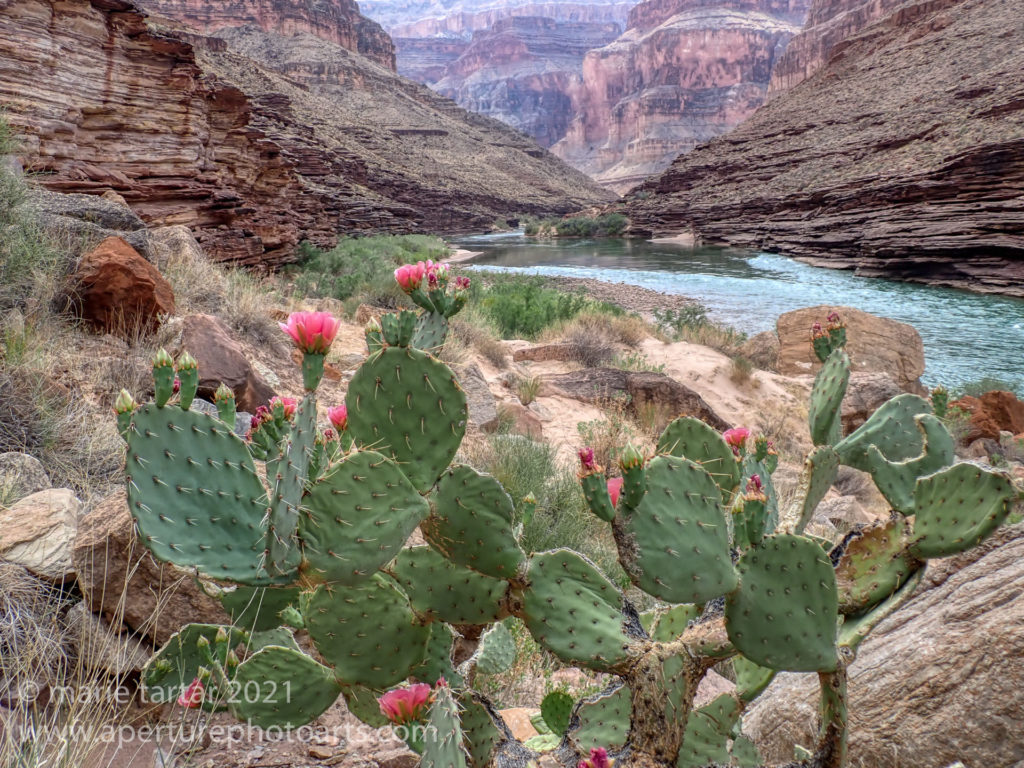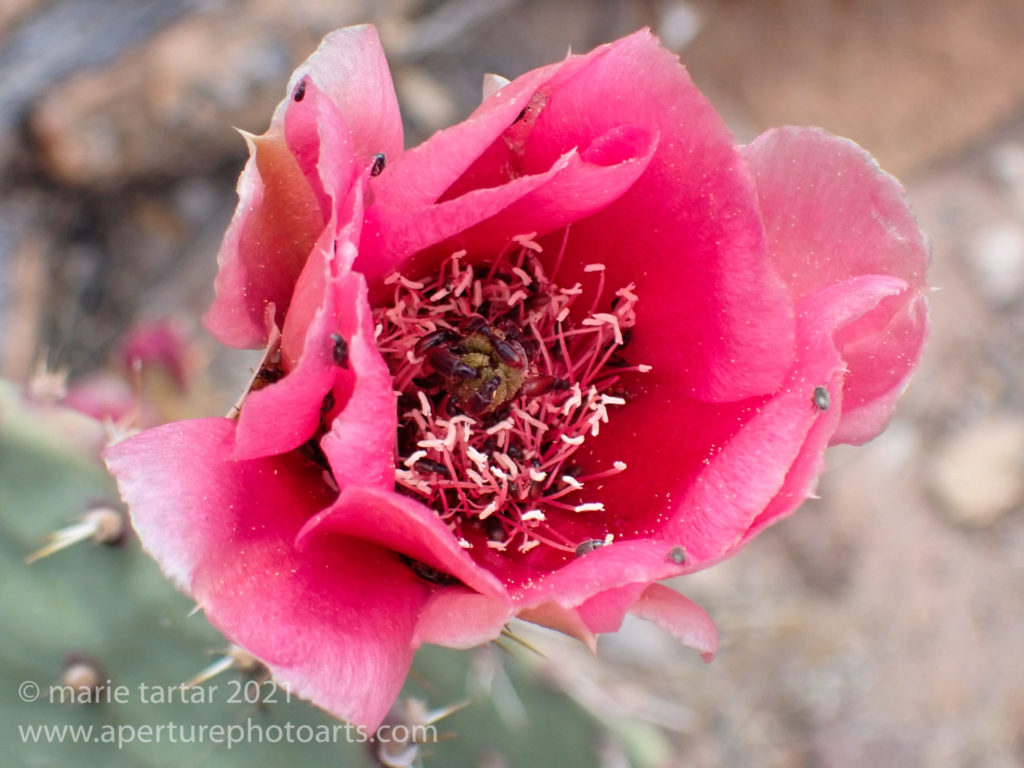
Day 4, Cardenas to Trinity Creek Camp, Mile 92
Today was billed as a Big Rapid Day, including Horn Creek. Rapids reflect constrictions in the canyon and rocks and boulders underwater, usually at intersections with tributaries and side canyons. During our trip, we have relatively low water flows, ranging from 8500-13,000 cubic feet/second (cfs). I had already been struck by how different the color of the river is from my prior trips, both in September, when the murky sandy tannish-pink color reflected sediment washed into the river from storms. I remember water being filtered for abundant sediment during prior trips. The Mormons described the water as “too thick to drink and too thin to plow”. This spring trip, the river has been a consistent gorgeous emerald. Colorado River means red river and presumably refers to the stirred up, sediment-abundant look of the river, but the color reminds me more of an abandoned strawberry milkshake. Even the shimmering glacial blue of the Little Colorado River can be transformed to muddy brown with sufficient storm activity.
A change over time since my prior river trips is the progressive erosion of sandy beaches. The river, downstream of Glen Canyon Dam and with its flows controlled, does not undergo the seasonal fluctuation of water flows of its unfettered state. High flows used to periodically rearrange and flush some obstacles downstream. I’m reminded how dynamic an ecosystem this is, even in its dam-constrained state.
On this trip, we never have to filter water. Today, we stopped at Phantom Ranch to restock on water.
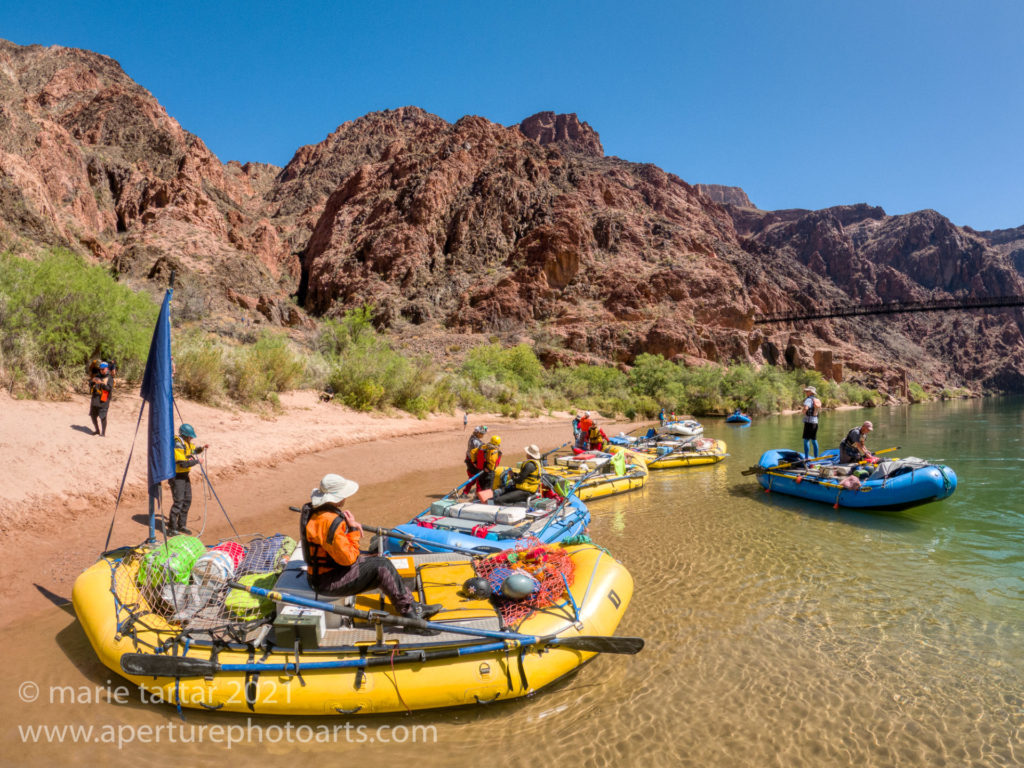
A cluster of inflatable oar-powered boats prepares to launch from Phantom Ranch, Mile 88 deep in the heart of Grand Canyon.
Making our way to Trinity Camp, we experience the extremes of Grand Canyon temperatures. The water is shockingly cold, every single splash bracing and gasp-inducing. At camp, we warm up quickly, as it is 93 degrees F, causing us to huddle under the quickly erected sunshade. While waiting for the sun’s intensity to wane, an impassioned discussion about stewardship of Grand Canyon is engendered.
We waited until 4 pm to hike back into the colorful canyon backing our campsite. Its interior was shaded and cool, with interesting and sculptural wall formations inside the increasingly narrow canyon. The terrain also became increasingly difficult. I didn’t make it very far into the canyon, as the Fuji XT-4 suddenly seemed to malfunction while working to capture fine details of the walls.
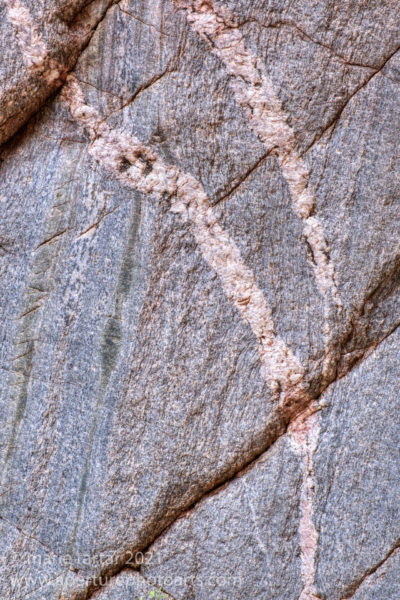
Pink Zoroaster granite, once molten, flowed into fissures to form this a kelp stalk decoration on a wall in the canyon backing Trinity Camp, Mile 92, in Grand Canyon.
Apparently I accidentally pushed the display button, as Adam quickly sorted out back at camp. It did get me back into camp in time to try out the Sony and the tiny split neutral density filter on the golden swirls of late afternoon sun in the water at the river’s edge.
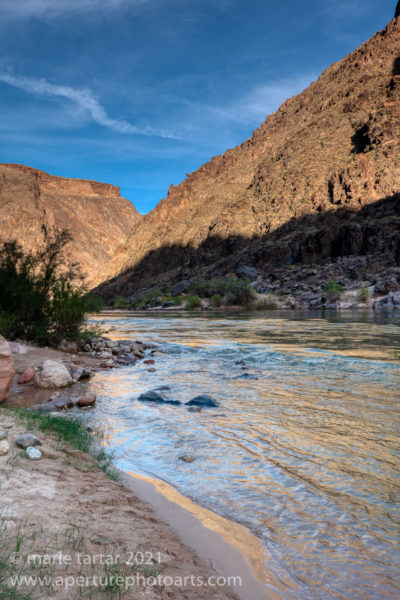
The view of the Colorado River in Grand Canyon from Trinity Camp, Mile 92, taken with Greg’s ridiculously full-featured tiny Sony RX100VI and the world’s tiniest 3-stop Nisi filter.
A guacamole appetizer heralded a Mexican dinner of chicken street tacos.
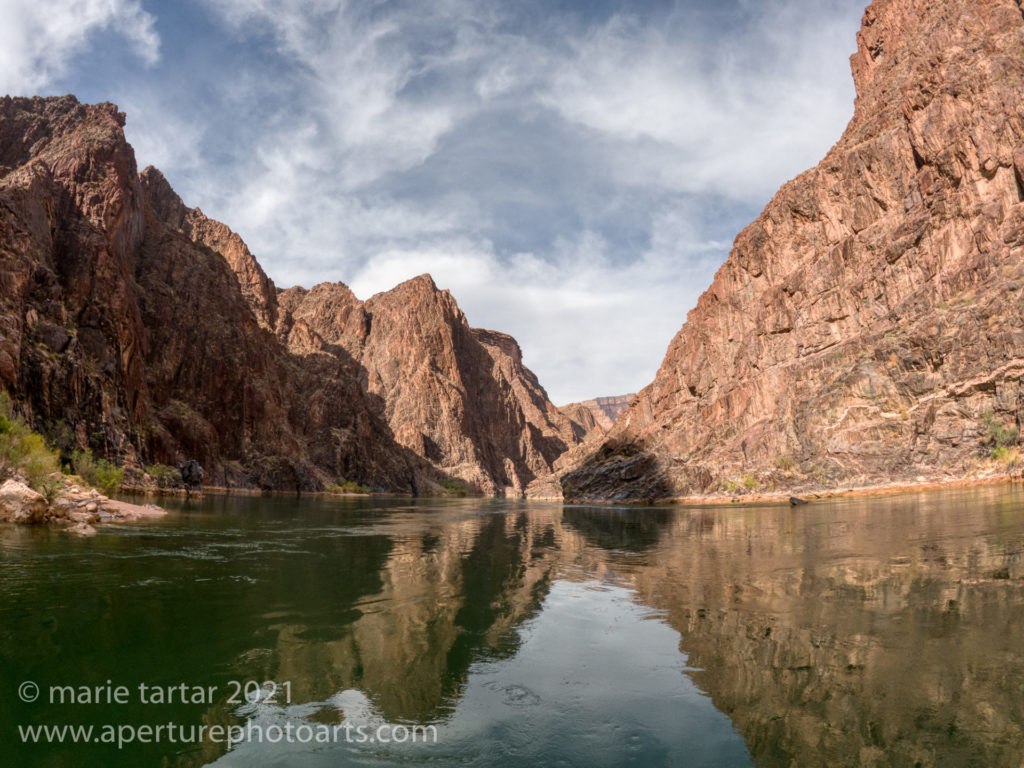
Back on the watery road, the Colorado River in Grand Canyon, setting off from Trinity Camp at Mile 92. (GoPro image, one of the times it actually heeded my injunctions: “GoPro, photo capture.”)
This was another Big Rapid Day, including the infamous Crystal rapid, which Adam has previously swum involuntarily. Crystal wasn’t always so notorious. Prior to 1966, it was placid, but was transformed overnight by a debris flow from Crystal Creek. This was also the site of a series of capsizes and a passenger death in 1983 during extremely high flows, events highlighted dramatically in The Emerald Mile, leading the National Park Service to halt traffic upriver in order to have passengers walk around the rapid rather than run it.
Cloud cover kept the sun’s intensity down, although we could have used its warmth. Being in the front this morning on the S rig meant a regular drenching. I wore a rain jacket but not the pants, whose lining by now was shriveling and shedding, so I’m not really sure they would have made a difference.
We flow through varied and interesting scenery, with veins of Zoroaster granite shooting through fissures and weaknesses of the underlying substrate. Red wall limestone and Tapeats sandstone dominate here. We see bighorn sheep regularly down at the water’s edge, although never close enough range for the waterproof cameras to which I have access. I think longingly of the long lens that is safely tucked in the big waterproof camera bag.
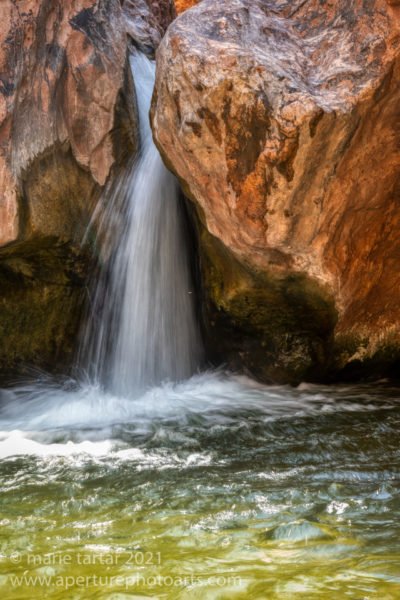
Water in the desert, always a welcome sight, in Grand Canyon on the Colorado River, taken with the tiny Sony.
The day’s highlight and indeed a highlight of the trip, was an extended afternoon shoot under a diffused sky of Elves Chasm at Mile 117.5 at Royal Arch Creek. Getting there with camera backpacks and tripods was another agility test, with the trail sandy and the rocky surfaces smoothly eroded by the passage of many feet over the years. It was so worth the effort, wonderfully cool and so naturally lovely.
Adam orchestrated an orderly progression of 1-2 photographers at a time, with injunctions for us to cross the few feet of water using stepping stones, so as not to track wet footprints across the stone in the foreground.
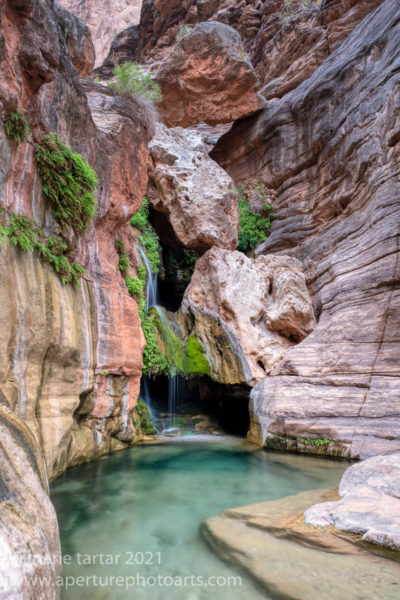
We managed to keep wet footprints from marring the stone foreground at Elves Chasm at Royal Arch Creek in Grand Canyon at between Miles 117 and 118.

Beautiful Elves Chasm, a magical secret hidden in a recess of the Grand Canyon at Royal Arch Creek near Mile 117.
Our camp for the night is Big Dune just down the river corridor. Ring-tail cats reportedly favor this camp, although they didn’t make an appearance, much to my disappointment. We spent two freezing nights camping in the Tonto Forest near Payson last October with Dano Grayson and Nancy and Gerry, with camera and flash set-ups and bacon grease to entice the critters, only to be literally skunked-the only creature to show was a beautiful hooded skunk.
This camp offers plenty of exercise. In addition to the “bag line” offloading the gear, this camp requires trudging through thick sand between the kitchen and individual campsites. My personal camp features a convenient shelf formed by the Tapeats sandstone backdrop. This Groover has the finest bathroom view yet on this trip. It is hidden behind and framed by giant boulders. At the hand wash station in the dark on the sandy path, my headlamp also illuminates a HUGE spider shadow, but try as I might, I could not locate the actual spider, so I beat a hasty retreat.
It was Italian night for dinner, featuring a salad and penne pasta topped with a hearty red meat sauce.
Adam cleared up a few camera mysteries I had been struggling with. Apparently, using the electronic shutter was disabling some other features.
The night sky shoot was more of a group event tonight, with Joe, Bill, Adam, Chris and Scott up with me in the dark, creeping around in the dark by red headlamp, trying not to wake those sleeping. We caught a few hours sleep afterwards before the sun and the “COFFFFFEEEEE” cry rang out at 5:30 am to start another day.
Day 6: Big Dune to Stone Creek Camp, Mile 132
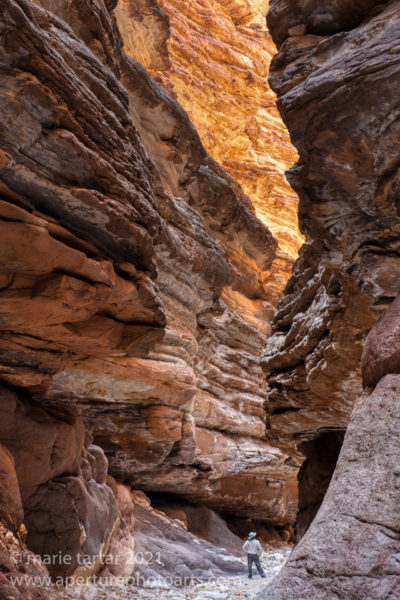
Joe (aka “Pepito”) modeled for me and looks extra diminutive in the slot of Blacktail Canyon at Mile 120 of Grand Canyon.
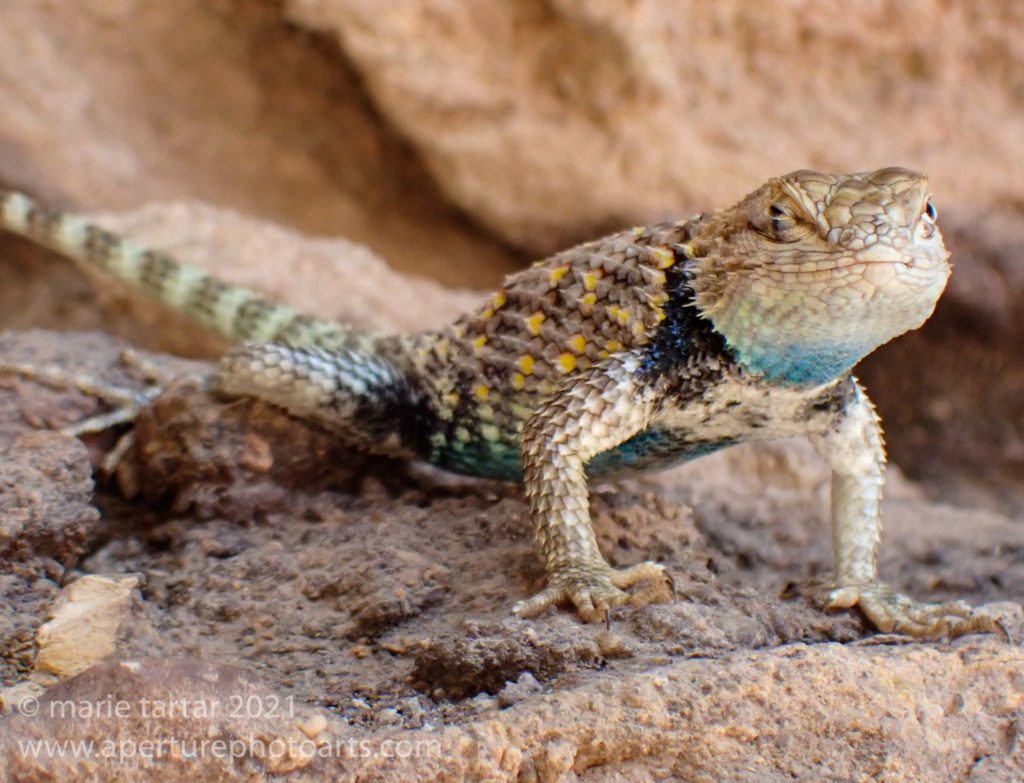
This male Yellow-backed Spiny Lizard (Sceloporus uniformis) was only too ready for his close-up, at Randy’s Rock in Grand Canyon.
When I arrived back on the boat, Adam suddenly asked if there was interest in staying longer for photography. From being packed up and ready for departure, suddenly the baby J’s load was being unlashed and the camera bags handed down the line. I climbed up to a little shelf for the view along the canyon. A blooming prickly pear provided a colorful foreground, as well as material for macro after I traded the big rig for the Olympus TG-6.
Adam was descending as I climbed up, with the water bottle I had just realized I left behind.Afterwards, I rode on the Baby J in front, which required squatting with both hands hanging onto the straps lashing the load of camera bags. Ever since my ACL reconstruction, I don’t squat very well. I was literally swept off my feet at one point as water gushed up from below in a billowing tidal wave.
This was a very windy corridor . Adam’s hat was sacrificed to the river deities on the way, but not seen again or recovered.
At the broad sand beach of Stone Creek camp, gusts of wind scattered everything not tied down. Although I thought I had left my camp secure, I returned to find my cot holding down my sleeping bag and the Paco Pad blown to the shore, stuck momentarily between a pair of larger boulders. Bill later told me Ann had helped batten down the hatches in our absence.
After washing my hair, I walked in and along the creek with Art to find Adam, Scott, Chris and Joe shooting Stone Creek’s lovely red rock waterfall.
Thai curry over rice and cucumber salad was a big hit at dinner. Chocolate was mentioned for dessert, but then couldn’t be located. Cookies and M & Ms appeared.
We were now 2/3rds of the way through our journey, with only a few casualties sustained (Chris’ lens, Adam’s hat and I misplaced a pair of gloves at one of our stops, wrung out to dry but not relocated when it was time to depart). We were bursting with memories and images and still had 3 days to go…to be continued, in a future and final Grand canyon post.


